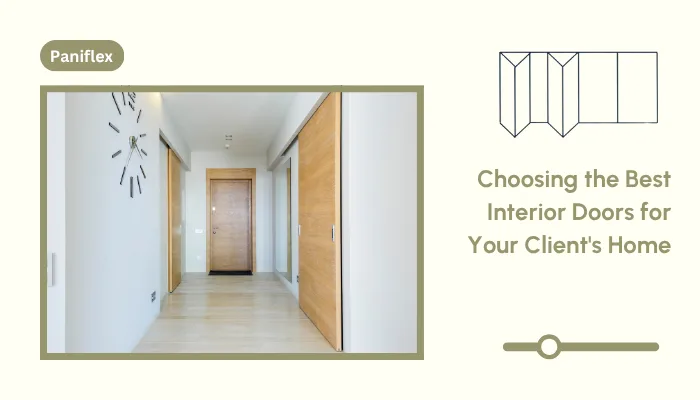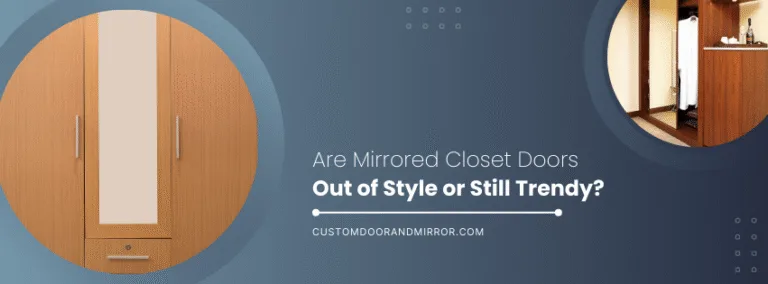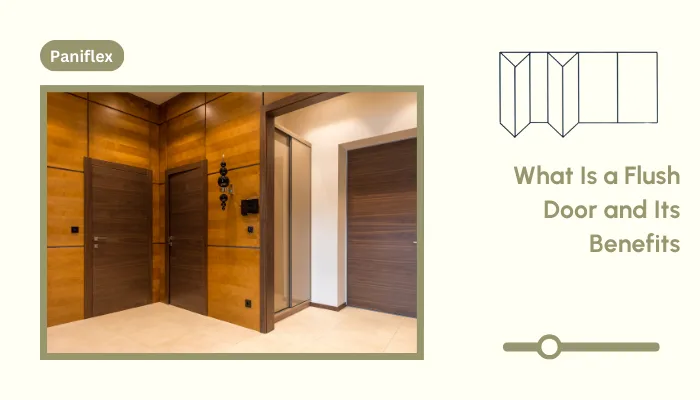Selecting the right interior doors is a critical decision in any design or construction project. Whether you prioritize privacy, space efficiency, or design cohesion, the right door can enhance both the form and function of any room.
We understand that as architects, designers, and builders, you often face the challenge of balancing appeal with practical considerations, all while meeting your clients’ diverse needs and preferences. We know that balancing style, durability, and budget is no easy task. That is why we have created this guide to help you make informed choices.
Ready to experience the benefits of custom closet doors? Explore our range of Paniflex products now.
TL;DR
- Match Style with Function: Consider each room’s purpose. Solid-core doors offer soundproofing for bedrooms, while glass panels suit airy, shared spaces.
- Material Matters: Choose from MDF, solid wood, or hollow core based on budget, durability, and other needs.
- Customize for Impact: Personalization in the form of panel designs, finishes, and hardware enhances both form and function.
- Think Long-Term: Opt for doors that complement the home’s architecture and require minimal maintenance.
Key Factors to Consider When Choosing Interior Doors
Selecting the right interior door involves more than just choosing a style or finish. It’s essential to consider various factors that can affect both the functionality and the overall design of a space.
These are a few key elements to consider before you purchase an interior door:
1. Room Functionality
Each room in a home serves a different purpose, and the doors should reflect that. For example, a bedroom door needs to offer both privacy and soundproofing, while a door for a laundry room may require durability and ease of cleaning.
For high-traffic areas like hallways, you may want a door that can withstand wear and tear, while more decorative rooms, such as living rooms, allow for more stylistic choices.
2. Material Selection
The material of the door will significantly impact its durability, appearance, and functionality. Common materials include:
- Solid Wood: Offers a classic, high-end look with excellent soundproofing qualities, but is generally heavier and more expensive.
- MDF (Medium Density Fiberboard): A more affordable option that provides a smooth surface for painting, though it may not be as durable as solid wood.
- Glass: Ideal for spaces that need to feel open and bright, such as living rooms or office spaces, but may require additional privacy considerations (frosted or tinted glass can help address this).
- Hollow-Core Doors: A lightweight, budget-friendly option for interior doors, often used in areas where soundproofing isn’t a major concern.
3. Design Style
The door should complement the overall design style of the space. It’s an opportunity to enhance the room’s mood, whether through contemporary simplicity or vintage charm. Consider the style of the room before you purchase an interior door:
- Modern: Clean lines, minimalistic designs, and often glass or sleek finishes.
- Traditional: Raised panels, natural wood finishes, and more ornate designs.
- Transitional: A blend of modern and traditional styles that can work in various settings.
4. Space and Size
Proper measurements are key when selecting interior doors. Incorrect sizing can lead to installation issues and gaps that affect both appearance and functionality. Take accurate measurements of the door frame and consider the following:
- Door Width: Ensure the door fits the designated frame, whether it’s a single, double, or sliding door.
- Clearance: Account for swing space if the door opens into a room. For smaller rooms, consider a pocket door or sliding door that doesn’t require a swinging arc.
- Height: Standard door heights typically range from 80 inches, but taller doors can create a more dramatic effect, especially in rooms with high ceilings.
5. Color of the Walls
Doors should either complement or contrast with the wall color, depending on the desired effect. Consider the room’s natural lighting and the atmosphere you want to create when deciding if your doors should be lighter or darker than the walls.
- Darker Doors: Darker doors can add depth and contrast, making a bold statement. They work well in both modern and traditional spaces, creating a rich and sophisticated feel.
- Lighter Doors: On the other hand, lighter doors can make a room feel brighter and more open. They are often used in contemporary or transitional designs to create a clean, seamless look.
After understanding the key considerations for selecting the right interior door, it’s essential to explore the various door types available. Each style offers unique benefits and can dramatically affect the designer appeal of a room.
In the next section, we will walk through the most popular interior door options to help you select the perfect fit for your project.
Suggested Watch: This video breaks down the key differences between door styles.
Types of Interior Doors to Consider
There are several types of interior doors available, each with its own unique set of benefits and design possibilities. Understanding the various options will help you choose the most suitable style and functionality for each room.
Whether you are working with a modern space or a traditional setting, there’s a door style to suit every project. The more common types of interior doors include:
1. Panel Doors
Panel doors are the most common type of interior door, offering a classic look with clean lines. They come in a variety of designs, from single-panel to multi-panel, and can be crafted from wood or MDF. Panel doors are well-suited for almost any room, making them a versatile choice for both traditional and modern homes.
2. French Doors
French doors are a timeless and elegant option, typically featuring glass panels within a wooden frame. They are often used to connect two rooms or provide a visual link to the outside. French doors can be an excellent choice for areas where natural light is a priority, such as living rooms, kitchens, or offices.
3. Barn Doors
Barn doors have become increasingly popular for their rustic charm and unique look. These doors slide open on a track, making them a great option for spaces where traditional swing doors might be too bulky. Barn doors are especially suited for smaller areas, like bathrooms or closets, where maximizing space is essential. They can also add a distinctive design element to modern or farmhouse-inspired interiors.
4. Sliding Doors
Sliding doors are another space-saving option, commonly used for closets, bathrooms, or even as room dividers. These doors glide along a track, making them an ideal choice for tight spaces where swing doors would be impractical. Sliding doors can come in various materials, including wood, glass, or mirrored panels, offering both style and functionality.
5. Pocket Doors
Pocket doors are perfect for narrow spaces where swinging doors can obstruct movement. These doors disappear into the wall when opened, allowing for more efficient use of space. Pocket doors are often used in bathrooms, closets, and hallways. They provide a sleek, modern look while maximizing room space.
6. Louvered Doors
Louvered doors feature slatted panels that allow for ventilation and airflow while maintaining privacy. These doors are often used in laundry rooms, pantries, or utility closets where airflow is important. The slats allow air to circulate freely, making them an excellent choice for rooms that may be prone to humidity or odor buildup.
7. Glass Doors
Glass interior doors offer a clean, modern look that allows light to pass through while still providing privacy. Whether frosted, clear, or tinted, glass doors can be used in a variety of settings, including offices, living rooms, and even bathrooms. These doors can help open up a space and make a room feel larger and more connected.
After selecting the perfect door style, it’s essential to consider the hardware and accessories that will complement it. Let’s explore the key elements that can enhance the appearance and functionality of your interior doors.
Suggested Read: Guide To Sizing A Rough Opening For Bifold Doors
Importance of Door Hardware and Accessories
While the door itself plays a central role, the hardware and accessories you choose can significantly enhance or detract from the overall look and performance. The right door hardware should complement the door style while also ensuring ease of use and durability.
These are the various hardware options and accessories to consider when selecting interior doors.
Choosing the Right Hardware
The hardware you select, such as handles, locks, hinges, and latches, should align with the door’s design and purpose.
- Handles: Door handles are available in a variety of styles, from simple knobs to elaborate pulls. The choice of handle should match the overall look of the door. For instance, a sleek, modern door might pair best with a minimalist handle, while a vintage-style door may benefit from a more ornate design.
- Locks and Latches: Privacy is an essential consideration, especially for doors to bedrooms or bathrooms. Choose locks that are both secure and easy to operate, such as lever or knob locks. For doors in public areas, consider non-locking handles for convenience.
- Hinges: The right hinges ensure the door opens and closes smoothly. Decorative hinges can add a touch of flair to traditional or rustic doors, while concealed hinges work well for modern designs that focus on clean lines.
Decorative Hardware
For many interior doors, hardware acts as a key design element. Depending on the style of the door, decorative hardware such as antique-style handles, unique hinges, or even custom-crafted door knockers can enhance the room’s overall look.
- For Classic or Traditional Styles: Ornate hardware, such as brass or bronze finishes, can add a vintage feel.
- For Contemporary Designs: Sleek, simple hardware like stainless steel or matte black can complement a minimalist or industrial design.
- For Rustic and Farmhouse Looks: Weathered or distressed hardware, such as wrought iron or barn-style pulls, can be the perfect touch.
Matching Hardware to Door Style
Selecting hardware that complements the door’s design is crucial for achieving a cohesive look. A well-matched hardware set ensures that the door feels complete and intentional. For example:
- Traditional Panel Doors: These pair well with solid brass knobs or antique-style handles.
- Glass Doors: These benefit from more delicate hardware, such as brushed nickel handles or transparent acrylic knobs.
- Sliding Barn Doors: These often look best with industrial-style hardware featuring visible tracks and large, robust handles.
Finishes and Material Considerations
The finish of your door hardware can also impact the room’s appearance. Popular finishes include:
- Polished Chrome or Nickel: Ideal for a modern, sleek look.
- Brass or Bronze: Often used for vintage or traditional designs.
- Matte Black: A contemporary choice that works well in industrial or modern spaces.
Once you have selected the right hardware, the next step is managing your budget. With so many options available, it’s important to understand the costs involved and find a balance that works for both your design needs and financial constraints. Let’s take a closer look at how to budget for interior doors effectively.
Suggested Read: DIY Ideas for Replacing HVAC and AC Closet Doors
Budgeting for Interior Doors
Choosing the right interior doors requires careful consideration of both design and cost. Balancing the look and quality of your doors with your project’s budget is important, especially when working on bigger renovation projects or installing many doors.
Factors That Affect Door Costs
- Material: Solid wood, for instance, is generally more expensive than MDF or hollow-core doors, but offers durability and a higher-end feel.
- Customization: Custom-designed doors, whether in terms of size, finish, or hardware, typically come at a higher cost than pre-made options.
- Door Type: Specialty doors, such as French doors or sliding barn doors, may also increase the cost due to their design complexity and material requirements.
- Installation: Factor in the cost of professional installation, especially if the door requires custom fitting or advanced hardware.
Tips for Staying Within Budget
- Opt for Standard Sizes: If possible, choosing standard-sized doors can help lower costs, as custom-made doors tend to be pricier.
- Prioritize Key Areas: Focus your budget on high-impact areas, such as entryways or main living spaces, while using more cost-effective options for rooms like closets or utility areas.
- Consider Pre-Made Options: If you are on a tight budget, pre-made doors can offer significant savings without compromising quality or style. Many pre-made options provide a wide range of designs and finishes.
While it’s tempting to cut costs in the short term, remember that doors contribute significantly to the value of a home. With a clear understanding of the various door styles and materials available, it’s time to focus on the best practices for making the right choice.
From the Community: Read this thread to discover more interior door recommendations.
Best Practices for Choosing the Right Interior Door
Choosing the ideal interior door requires a combination of design sense, purpose, and foresight. Here are some additional tips to ensure you make the right choice for any space:
- Energy Efficiency: Choose doors with insulating cores or weather stripping that effectively reduce heat transfer, thereby lowering heating and cooling costs in temperature-sensitive rooms like bedrooms or offices.
- Consider Hardware Early: Before selecting your door, think about the hardware you will use, including handles, locks, and hinges. Matching the hardware style with the door’s material and finish early on ensures a unified design and prevents installation delays.
- Maintenance and Durability: Different materials require varying levels of maintenance. For instance, solid wood may need periodic refinishing, while MDF doors might be more resistant to wear and tear. Select a material that aligns with the space’s maintenance needs.
- Door Swing Direction: The direction in which a door swings can significantly impact a room’s functionality. Be mindful of door swings in smaller spaces where they could obstruct traffic flow, and plan for pocket or bi-fold doors if space is a concern.
- Long-Term Trends: While trendy designs might be appealing, consider the long-term value and how the door will fit into future renovations or updates to the home. Choosing a more timeless style can ensure your client’s investment lasts beyond current trends.
- Noise Reduction: If you are working on a project that requires controlling sound between rooms, such as in a home office or media room, consider doors with solid cores or specialized soundproofing features to minimize noise transfer.
Now that you have a solid understanding of the best practices for selecting the right door, it’s time to consider the options available to you. One of the key decisions in choosing an interior door is whether to opt for custom-made doors or go with pre-made, stock options. Each choice has its benefits, and selecting the right one depends on the specifics of your project.
Suggested Read: How to Install Sliding Closet Door Floor Guides on Various Surfaces
Custom vs. Pre-Made Interior Doors
Custom interior doors allow for a high degree of flexibility and personalization, making them ideal for spaces with unique design requirements. Whether you need doors for non-standard openings, specific design features, or high-end finishes, custom doors can meet these demands.
Pre-made or stock doors are a cost-effective and practical option for many projects. They come in a variety of styles, materials, and sizes, and are typically ready for installation right out of the box, making them ideal for projects with tight timelines.
Custom doors are often the best choice when a project involves unique design elements, non-standard room sizes, or high-end finishes. They are also ideal when the design requires a door that blends seamlessly with other custom architectural features in a space. However, it’s important to plan for a longer lead time and higher cost.
Pre-made doors are the go-to option when working within a budget or on projects with a standard design and timeline. They are also an excellent choice for larger-scale projects where uniformity is crucial, or when there’s a need to minimize installation times.
When deciding between custom and pre-made doors, it’s essential to weigh the unique needs of your project. For those seeking highly personalized designs, custom doors offer unparalleled flexibility and style.
Custom Door & Mirror is a leading provider of personalized doors that can meet even the most specific design requirements. In the next section, we will take a closer look at how Custom Door & Mirror can help bring your vision to life.
Why Choose Custom Door & Mirror for Your Project?
When it comes to providing high-quality doors and mirrors, Custom Door & Mirror stands out as a trusted partner for contractors, designers, and architects. With a reputation for precision and excellence, they offer a range of customizable options that ensure your design vision is perfectly brought to life.
Here’s why choosing Custom Door & Mirror could be the ideal decision for your next project.
- Fully Customizable: Get doors and mirrors tailored to your exact dimensions and design preferences.
- Extensive Selection: A wide range of styles, materials, and finishes to suit any project.
- Precision Engineering: Crafted with care for a perfect fit and long-lasting durability.
- Professional Service: Expert guidance and support from start to finish.
- Efficient Turnaround: Timely production and delivery to meet project deadlines.
The ability to deliver personalized solutions and high-end finishes makes Custom Door & Mirror a standout choice for any project. Their easy integration into existing designs has earned them the trust of contractors, designers, and architects seeking the best in door design and installation.
Ready to experience the benefits of custom closet doors? Explore our range of Paniflex products now.
Conclusion
Choosing the right interior doors is a pivotal decision in any construction or design project. From selecting materials and styles to considering functionality and fit, every detail matters. Whether you opt for pre-made doors to meet budget constraints and tight timelines or custom solutions that offer unparalleled flexibility and personalization, the doors you choose set the tone for the space.
Choosing Custom Door & Mirror ensures that you get doors built to last and tailored to your specific needs. Their custom solutions ensure a perfect fit, reliable performance, and long-term durability. With Custom Door & Mirror, you can rely on high-quality craftsmanship and a perfect fit for your project.
Contact Custom Door & Mirror to find an interior door that matches your exact specifications.
Frequently Asked Questions
What is the best choice for interior doors?
The best choice for interior doors depends on your space, budget, and style. Solid wood doors offer durability and insulation, while glass doors provide light and openness. Choose based on function and long-term value.
How to know which interior door to buy?
Consider the room’s purpose, material options, and design style. Measure door frames accurately, and think about privacy needs, durability, and maintenance. Assess your budget and timeline, and ensure the door complements the space while offering practical benefits.
How do I choose an interior door?
Choose an interior door based on size, material, style, and the room’s specific needs. Consider door types (e.g., hinged, sliding, or bi-fold) and functionality (e.g., privacy, ventilation). Matching the door to the room’s decor is also essential.
What interior doors never go out of style?
Classic solid wood panel doors and French doors remain timeless. Their versatile design complements almost any interior. Additionally, clean, simple designs, such as shaker-style doors, also have enduring appeal, offering elegance without being overly trendy or dated.






